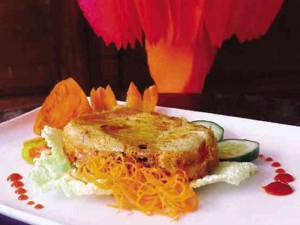
With unbelievable speed, “The Cuisine of Quezon” (Zoom Printing Company, 2013) was published.
The author, Milada Dealo Valde, was just talking about a cookbook she wanted to do in May; by the first week of August, it was launched.
It just showed that when this woman puts her mind to doing something, she gets it done, pronto.
Because Valde is from Lucban, most of the recipes come from this cool upland town famous for its Pahiyas festival. If you’re familiar with its food, you would look for its longganisa, pancit habhab and hardinera, and they are there. Hardinera, the celebratory meat loaf of the place, was my introduction to Lucbanin cooking. And Valde’s recipe may give away the secret as to why the hardinera in Valde’s family bakery and restaurant, Dealo Koffee Klatch, is the best I have ever tasted.
At the book launch, a huge hardinera was on display. Many of us wanted to have a taste of it but we were told the hotel would not allow it. Apparently the hotel didn’t allow any dish, not prepared in its kitchen, to be served; it didn’t want to be held accountable for any food problem.
Strange names
I did look for Bombay, the soup similar to the Tagalog batchoy where the main ingredients are cooked in a banana leaf pouch that resembles an Indian turban (hence the dish’s name). It reminded me of Iloilo’s tinuom nga manok, chicken steamed also in a banana packet.
For me, there were stranger names than Bombay. Pirihil turned out to be a dinuguan (blood stew) of chicken gizzard, heart and liver. Sinantomas is pork ribs or neck enriched with cheese, catsup, pineapple juice, vinegar and soy sauce. Karakas is crab cooked in buko (young coconut) meat and juice. Pasag-oy is pounded cooked cassava served with grated coconut in caramelized sugar.
This book was started a long time ago, according to Valde. The spadework was done with her friends who helped in the research and traveled to different parts of the province. One of those towns was Jomalig, an island in the eastern part which I didn’t even know about.
Halabos na hipon (steamed shrimps) was the recipe—quite simple, but this one used a clear lime-flavored soft drink. Cooking with soft drink happens all over the country, adding that special flavor to barbecue or an orange taste to some version of Cebu’s torta.
‘Ginanga’
Infanta’s sinantolan was there, reminding me of the time I interviewed some nuns of Sta. Clara about the food of the place, under huge santol trees. Grated santol is cooked with coconut milk and cream, sometimes as is or, in good times, with added ingredients such as shrimp and crab and one listed as ginanga.
There was no explanation of what it is, but browsing through the pages, we found a recipe for ginanga from Infanta. It is the province’s name for pangat, or cooking fish with a little water and very mild flavors.
One of the women from Lucban said the process is the same as sinaing, except that sinaing is used only for tulingan (tuna) and ginanga for other fish.
Bakuli, a small mudfish (dalag), in Quezon, is cooked as paksiw (braised in vinegar) with turmeric. Our language is so rich that we even have names for different sizes of fish. In Bulacan, the eel is igat when still small, becomes malabanos as it becomes bigger, then is called palos at its biggest size.
There should have been some translation for readers not familiar with the terms. Author Amy Besa, seated beside me, asked what balinghoy is (cassava). And she pointed out how other recipes listed cassava and kamoteng kahoy.
Another mystery was kamamba leaves added to the guinataang manok (chicken cooked in coconut milk. Kamamba (Piper umbellatum) is said to grow wild and its leaves give off a scent that has been compared to that of the oregano or rosemary.
Sometimes when you are too close to the subject matter, you presume that all readers know what you know.
Glossary
The glossary defines or describes local names. But in “The Cuisine of Quezon” the section was used for “food-related jargons” in the province, a rather entertaining reading.
The kitchen is called labas while the stove is abuhan. These probably hark back to the days when the kitchen was situated outside the main house and the stove was wood-fed, producing abo (ash).
Badly cooked rice is called alibukdan if still half-cooked, and angi if burnt. Spicy food is halang.
Cooking procedures include bangi (roasting), ibatad (marinate), niligis (mashed), yadyad (shred).
My favorite is birtud or secrets in traditional cooking.
“The Cuisine of Quezon” is birtud revealed in the recipes. Valde will finally have a cookbook to bring to her cooking demonstrations abroad, and the book will become part of our culinary heritage.
I wish that all provinces, even towns, could document their own recipes. It doesn’t have to be a full-color book. A Cavite cookbook I was given had photocopied pages with an ordinary folder for cover.
Either way, they show the world that we have a rich and varied cuisine.
E-mail pinoyfood04@yahoo.com.